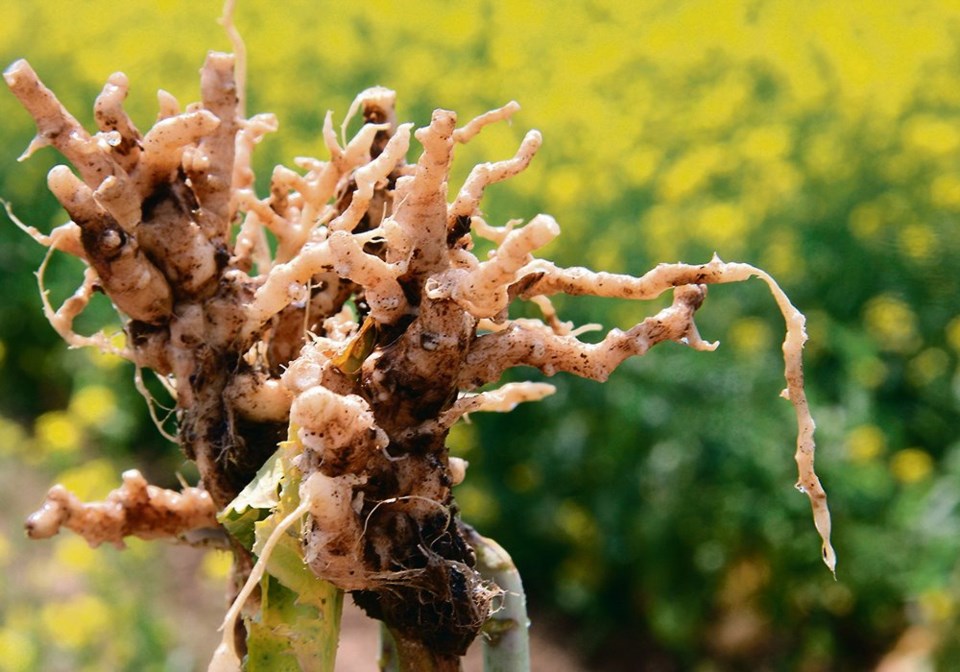WESTERN PRODUCER — In a survey of canola varieties with second-generation clubroot resistance, researchers found most of these cultivars developed moderate to high disease severity in response to at least some of the resistance-breaking clubroot pathogens they collected.
However, one of the canola varieties tested was resistant to just about all common clubroot pathotypes on the Prairies.
Last week, Stephen Strelkov, a professor of plant pathology at the University of Alberta, described research underway to monitor the spread of clubroot in the province, including with the Canadian clubroot differential, or CCD, set.
“Basically, what this is, is a group of different brassica varieties that we inoculate or we test with unknown strains of the pathogen, and then based on the virulence patterns of the unknown strains on these differentials we’re able to classify them or group them into different pathotypes,” Strelkov said during Alberta Agronomy Update online event Jan. 11.
The CCD set shows there’s a significant diversity in clubroot pathotypes in Canada.
As of 2020, 43 pathotypes were confirmed in the country with a CCD set, and 25 of those can overcome the resistance in at least some clubroot resistant canola, while 18 do not overcome it.
Monitoring resistance-breaking pathotype is important to manage clubroot, so researchers have been watching how well resistant cultivars are holding up.
Strelkov said the term first-generation resistance is used to denote the resistance that was first made available for Canadian growers.
This resistance was used in many varieties, and it’s controlled by a single dominant gene.
“Most infected clubroot-resistant canola samples that we received and tested up to 2018 consisted of this first-generation resistance,” Strelkov said.
Since the emergence of resistance-breaking pathotypes, there’s been an effort by many breeders to develop canola with what’s often referred to a second-generation resistance.
He said this is an important new tool for clubroot management particularly in fields where resistance has been broken in first-generation resistant cultivars.
However, the source or sources of the second-generation resistance is not in the public domain, so it can be difficult for researchers to understand the resistant mechanisms.
“Despite this kind of different nature from first- to second-generation resistance, we think second-generation resistance is likely still vulnerable to pathotype shifts,” Strelkov said.
So, researchers have been monitoring how well resistance varieties have been holding up by collecting field isolates from canola crops with second-generation resistance, but still display symptoms of clubroot.
So far 30 isolates have been collected.
The isolates were then tested for their ability to cause disease on seven commercial canola cultivars with second-generation resistance.
“What we do is that we inoculate or apply the pathogen to these hosts, and then we basically rate the plant from 0 to 3 for the severity, and then we use the combined data for each treatment to calculate the severity index that goes from 0, meaning no disease, to 100 precent, meaning that all the roots are severely infected,” Strelkov said.
He said there was a range of responses of the varieties carrying second-generation resistance, but most second-generation clubroot resistance cultivars developed moderate to high disease severity in response to at least some of the field isolates tested.
“We saw some that performed very strongly, so only 10 to 20 percent disease, some that were intermediate between 20 to about 35 percent disease severity, and some that unfortunately seem to be quite susceptible to most of these isolates, maybe 60 to about 75 percent of disease severity,” Strelkov said.
Two of the second-generation varieties tested appear susceptible to the older clubroot pathotype that was dominant before the first generation clubroot resistance broke down.
“Not sure what’s going on there. Perhaps with the focus on the resistance-breaking pathotypes, perhaps maybe there wasn’t enough emphasis on pathotype 3H, which is still quite prevalent,”
On the good news, a few cultivars performed very well, and one was resistant to 22 of 23 of the isolates we tested,” Strelkov said.
The names of the varieties have not been disclosed.

